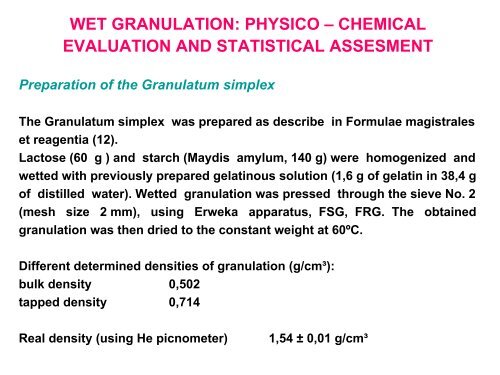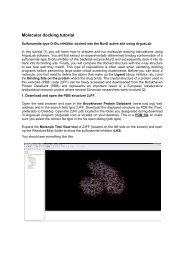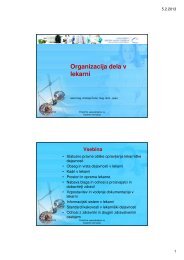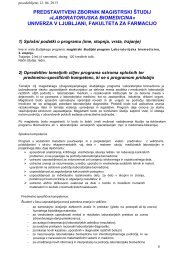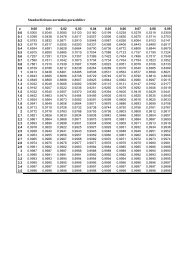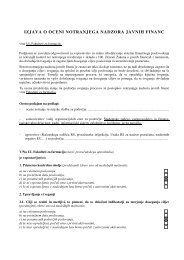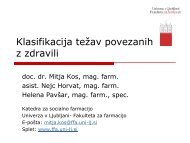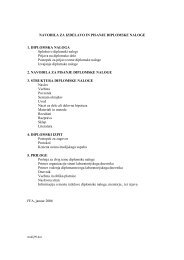WET GRANULATION: PHYSICO â CHEMICAL EVALUATION AND ...
WET GRANULATION: PHYSICO â CHEMICAL EVALUATION AND ...
WET GRANULATION: PHYSICO â CHEMICAL EVALUATION AND ...
You also want an ePaper? Increase the reach of your titles
YUMPU automatically turns print PDFs into web optimized ePapers that Google loves.
<strong>WET</strong> <strong>GRANULATION</strong>: <strong>PHYSICO</strong> – <strong>CHEMICAL</strong><strong>EVALUATION</strong> <strong>AND</strong> STATISTICAL ASSESMENTPreparation of the Granulatum simplexThe Granulatum simplex was prepared as describe in Formulae magistraleset reagentia (12).Lactose (60 g ) and starch (Maydis amylum, 140 g) were homogenized andwetted with previously prepared gelatinous solution (1,6 g of gelatin in 38,4 gof distilled water). Wetted granulation was pressed through the sieve No. 2(mesh size 2 mm), using Erweka apparatus, FSG, FRG. The obtainedgranulation was then dried to the constant weight at 60ºC.Different determined densities of granulation (g/cm³):bulk density 0,502tapped density 0,714Real density (using He picnometer)1,54 ± 0,01 g/cm³
Table 2: Parameters of granulation porosity at different pressure values.max PPressure(PSI)Porediameter(μm)Cumulativeintrinsicvolume (cm³/g)Cumulativeporesurfacearea (m²/g)0,7 251,1997 0,0020 0,0000 0,00027,5 24,1827 0,0216 0,0015 0,000415,1 11,9547 0,0471 0,0085 0,006625,6 7,0561 0,2414 max 0,0969 0,057354,7 3,3069 0,2591 ∆ vol. 0,1120 0,0063142,6 1,2680 0,2748 0,1361 0,0020338,6 0,5342 0,2866 0,1950 0,0267825,6 0,2191 0,2866 0,1950 0,00008880,6 0,0204 0,2885 0,5320 0,333623395,6 0,0077 0,2905 1,4252 0,926630163,5 0,0060 0,2905 1,4252 0,000014115,6 0,0128 0,2905 1,4252 0,00008403,6 0,0215 0,2905 1,4252 0,0000850,6 0,2102 0,2905 1,4252 0,0000156,6 1,1551 0,2905 1,4252 0,0000Differentialintrinsicvolume (dV/dD)(cm³/g•μm)
pressure (PSI, pounds per square inch) – pressure of mercury necessary for intrusion,1 PSI = 6895 Pa)pore diameter – diameter of pores which are filled under defined pressurecumulative intrinsic volume – cumulative pore volume in cm³ per g of the samplecumulative pore surface area – cumulative pore surface in m² per g of the sampledifferential intrinsic volume – increment intrinsic volume divided by pore diameterFigure 1: Cumulativepore volume per gram% vs. pore diameter(micrometers).Maximum intrusion == 0,2905 cm³/g
Figure 2: Differential volume per gram % vs. Pore diameter (micrometers).Maximum differential volume = 0,9266 cm³/g • μm.
Average diameter of the granulation before and after the friability test withcorresponding X² exp. values:log d X² exp.before: 2,53 3,5after: 2,43 5,9 X²tab = 13,277 α = 0,01Sieve analysisThe sieve with following mesh sizes were chosen: 80, 125, 200, 315, 500, 800μm to perform subsequently chi – square test for log – normal distribution ofparticles:X² = Σ ((O – E)² • E -1 )where O is observed weight of individual fraction and E is expected weightof the sample fraction, calculated from accomodated normal distribution.
Table 3: The masses shaken and corresponding chi – square values.Granulation mass (g) 10 30 50 100 200X²exp 3,1 8,9 29,1 54,8 110,1Table 4: The values for independent and dependent variablesIndependent variables(granulation properties)Dependent variables(tablet properties)granularsizefractionsgranulardiameter(μm)reposeangle (º)flow rate(g/s)crushingstrength(N)averagemass(mg)liberationconstant(min -1 )friability(massloss in %)1 0–80 41,4 0 72,7 446 0,34 1,802 80–125 33,0 33,0 69,7 479 0,32 1,463 125–200 33,3 32,3 89,6 474 0,36 1,094 200–315 30,8 36,1 87,9 432 0,27 1,235 315–500 26,6 36,1 99,6 438 0,11 0,876 500–800 24,2 34,9 113,5 518 0,23 0,787 800< 22,5 34,9 108,2 467 0,19 0,86
Bulk densities for different granule size fractions:granule sizefractions 1 2 3 4 5 6 7bulk density(g/cm³) 0,548 0,555 0,562 0,650 0,643 0,655 0,554Dissoltion rate constant (k) is calculated from:ln(c ∞ –c t ) = ktc ∞ – the concentration when all the drug is dissolvedc t – the concentration of the drug at time tSimple regression procedure was performed using four different models:a) linear: y = a + bxb) exponential: y = e a+bxc) reciprocal: 1/y = a + bxd) multiplicative: y = a · x bThe values for granulation parameters represented the independent variablex and the values for tablet parameters are taken for dependent variable y. InTable 4 all the values for both variables are presented.
Correlation coefficients for each pair of tested parameters are presented in Table 5.Table 5: Correlation coefficients for different pairs of tested parameters.Independent Dependent variablesvariablesregressionmodelcrushingstrengthaveragemassliberationconstantfriabilityL 0,857 0,204 0,654 0,776granule E 0,841 0,198 0,545 0,803diameter R 0,822 0,192 0,416 0,817M 0,921 0,099 0,640 0,939L 0,892 0,153 0,753 0,939repose E 0,885 0,138 0,670 0,939angle R 0,872 0,123 0,562 0,928M 0,897 0,165 0,672 0,932L 0,534 0,025 0,454 0,786flow E 0,546 0,039 0,413 0,719rate R 0,554 0,052 0,360 0,650M – – – –Legend: L-linear model, E-exponential model, R-reciprocal model, M-multiplicative model


